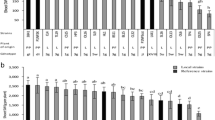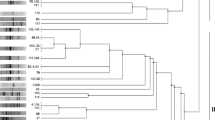Summary
Pisum sativum ecotype fulvum forms ineffective nodules with Rhizobium strains, isolated from effective nodules of the cultivated pea in Europe. Rhizobium strains isolated from nodules of fulvum peas in Israel are fully effective on this host plant, but in association with the cultivated pea they induce nodules of poor N2-fixing activity. The distribution of these fulvum-specific Rhizobium strains is restricted to regions where the fulvum pea occurs naturally. Rhizobium strains from other geographical regions induce mainly ineffective, or partially effective nodules on fulvum plants.
A wide genetic variation, with regard to symbiotic response to a standard set of Rhizobium strains, was demonstrated in the fulvum plants collected in Israel. Based on variation in N2-fixation three groups of plants can be distinguished. These plants offer the possibility for the study of host-genetic control on symbiotic nitrogen fixation.
Similar content being viewed by others
References
Ben-Ze'ev, N. and Zohari, D. 1973 Species relationships in the genus Pisum L. Israel J. Bot.22, 17–24.
Frankel, O. H. and Bennett, E. 1970 Genetic resources in plants-their exploration and conservation. Blackwell Scientific Publications, Oxford and Edinburgh.
Lamprecht, H. 1974 Monographie der Gattung Pisum. Steiermärkische Landesdruckerei, Graz.
Leppik, E. E. 1970 Gene centres of plants as sources of disease resistance. Annu. Rev. Phytopathol.8, 324–344.
Lie, T. A. 1971 Temperature-sensitive root-nodule formation in pea cv. Iran. Plant and Soil34, 751–752.
Lie, T. A., Hille Ris Lambers, D. and Houwers, A. 1976 Symbiotic specialisation in pea plants: some environmental effects on nodulation and nitrogen fixation.In Symbiotic Nitrogen Fixation in Plants. Ed. P. S. Nutman, pp 319–333, Cambridge Univ. Press, Cambridge.
Lie, T. A. 1978. Symbiotic specialisation in pea plants: the requirement of specific Rhizobium strains for peas from Afghanistan. Ann. Appl. Biol.88, 462–465.
Lie, T. A., Timmermans, P. C. J. M. and Ladizinsky, G. 1981 Host-controlled nitrogen fixation inPisum sativum ecotype fulvum.In Current Perspectives in Nitrogen Fixation. Eds A. H. Gibson and W. E. Newton, p. 419, Australian Academy of Science, Canberra.
Lie, T. A. 1981 Environmental physiology of the legume-Rhizobium symbiosis.In Nitrogen Fixation. Vol.1, Ecology. Ed. W. J. Broughton pp 104–134 Oxford Univ. Press, Oxford.
Vavilov, N. I. 1951 The origin, variation, immunity and breeding of cultivated plants (English translation), The Ronald Press Co., New York.
Winarno, R. and Lie, T. A. 1979 Competition between Rhizobium strains in nodule formation: interaction between nodulating and non-nodulating strains. Plant and Soil51, 135–142.
Author information
Authors and Affiliations
Rights and permissions
About this article
Cite this article
Lie, T.A. Gene centres, a source for genetic variants in symbiotic nitrogen fixation: Host-induced ineffectivity inPisum sativum ecotype fulvum. Plant Soil 61, 125–134 (1981). https://doi.org/10.1007/BF02277369
Received:
Issue Date:
DOI: https://doi.org/10.1007/BF02277369




